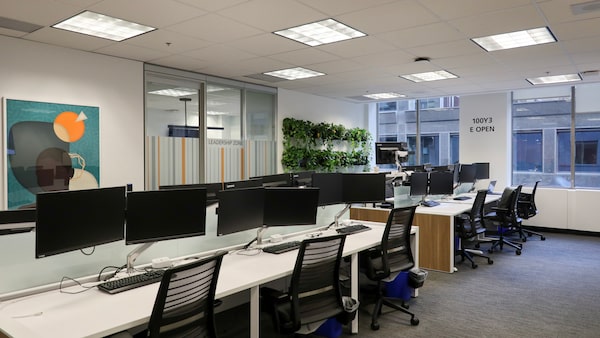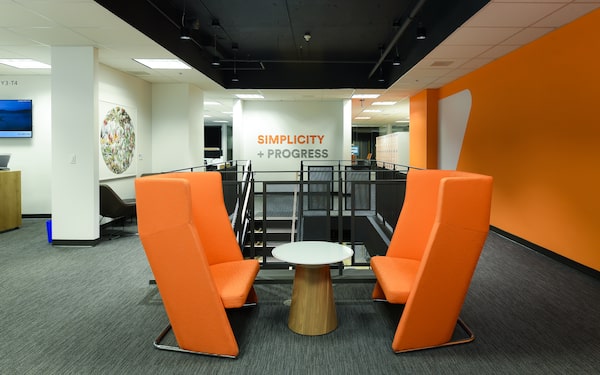
Tangerine has opened a new downtown office space at 100 Yonge St., featuring the company’s colour scheme and logos on both floors of the 22,000-square-foot space.Wallace Immen/The Globe and Mail
Tangerine Bank felt the suburban location of its Toronto headquarters at Steeles Avenue East near Highway 404 might be affecting its ability to bring staff back to the office after the pandemic and stay on top of the curve in the digital banking market.
“In speaking with employees, we regularly heard that people who live downtown wanted an opportunity to work downtown,” says Natalie Jones, chief marketing officer of Tangerine Bank. Employees also wanted more options to commute by transit rather than having to drive.
It led to a decision to open an additional office in the downtown financial district. “We have an ambitious agenda to grow our team and bring in new talent. We believe convenient access by GO train, TTC and Bike Share will attract new talent to join our team,” Ms. Jones explains.
It’s a theory that was prevalent before 2020, when Toronto’s downtown office vacancy rates were in the low single digits. Offices located downtown were seen as essential to attract young talent who enjoy the amenities of urban life and want to avoid long commutes. But the equation changed in the work-from-home era of the COVID-19 pandemic. Suburban offices with ample parking gained an advantage amid social distancing as commuting by car rather than public transportation became more attractive.
The suburban and downtown markets are their own ecosystems.
— Jonathan Peretz, executive vice-president and managing director, JLL GTA.
Vacancies in Toronto’s core rose from 5 per cent in the fourth quarter of 2020 to 15.7 per cent in the same quarter of 2023, according to a Toronto Office Insight report by commercial real estate firm JLL. That’s now slightly higher than the vacancy rate in Toronto’s northern suburbs, which had been close to 10 per cent in 2020 and is now averaging 15 per cent, according to the report.
Toronto’s soft demand has been a factor in pushing Canada’s national downtown office vacancy rate to a record high of 19.4 per cent at the end of 2023, according to a study by real estate company CBRE. In contrast to declines in downtown markets, the fourth quarter saw widespread increases in suburban office market occupancy, with eight cities reporting declining suburban office vacancy, the report added. The best performers were Winnipeg, Edmonton and Montreal, according the CBRE study.
Caution is in order when comparing vacancy rates because the shifts have not been seismic, and “the suburban and downtown markets are their own ecosystems,” says Jonathan Peretz, executive vice-president and managing director of JLL’s Greater Toronto Area office.
To increase the appeal of suburban buildings, landlords have been adding amenities that are more plentiful downtown. “I’m seeing suburban landlords put gyms, tenant lounges and food and beverage outlets into their buildings so people can get away from the office without having to drive somewhere else,” Mr. Peretz says.

The new office is designed with a much wider variety of workspaces, meeting rooms and dedicated quiet spaces.Ludwing Duarte/The Globe and Mail
“We have also seen inducements go up, in terms of allowances and free rent in both markets,” he adds. “Class B and C buildings have more competitively priced rents, while the rents in trophy towers downtown have slightly increased.”
“Office tenants are looking to provide the best possible office environments to encourage their employees to return to the office,” says Miles Kettner, a senior vice-president at CBRE Canada who specializes in Toronto suburban office leasing. “Plus, construction costs have risen, and a lot of tenants are challenged for capital, so the demand for high-quality, built-out space has increased.”
Shorter leases are also more popular. “During the pandemic, suburban tenants were looking for maximum flexibility and we were seeing leases as short as two or three years. Now, leases of five years are typical, compared to 10 years before the pandemic,” Mr. Kettner says.
In its move, Tangerine is still retaining a suburban presence to provide their teams with options. Employees are assigned a home base with flexibility to move between the 100 Yonge St. and Steeles Avenue offices, Ms. Jones says.
Founded in 1997 as ING Bank of Canada, it was acquired by Scotiabank in 2012 and operates as a separate digital bank that was rebranded Tangerine in 2014. It now has 1,200 employees in Canada.
As soon as you step off the elevator, it’s clear whose offices you’re in. Tangerine features in the colour scheme and logos on both floors of the 22,000-square-foot downtown space. The new office features a much wider variety of workspaces, meeting rooms and dedicated quiet spaces, Ms. Jones says. Meeting rooms all have built-in video and sound systems and feature whiteboard walls for brainstorming that encourage people to “write on me/erase after use.”
Accessibility and inclusion were paramount in the design, which includes tables to accommodate those with sensory disabilities, a universal washroom, as well as braille added to internal signage, Ms. Jones adds.
Artworks by artists of diverse backgrounds were commissioned for the space, including from acclaimed artist Cristian Fowlie, who created Pride-themed illustrations displayed on bikes upon the launch of Tangerine’s partnership with Bike Share Toronto.
In orientation meetings the first week of February, “employees were all smiles,” says Ms. Jones.
“Getting to walk around and investigate different spaces and different ways to work has been really energizing for the entire team.”